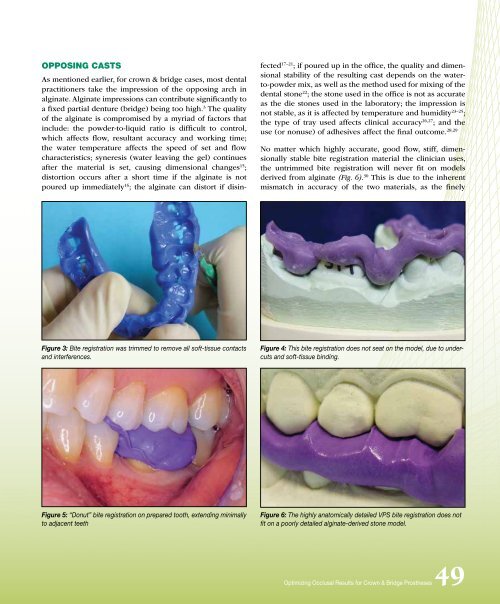PDF Version - Glidewell Dental Labs
PDF Version - Glidewell Dental Labs
PDF Version - Glidewell Dental Labs
You also want an ePaper? Increase the reach of your titles
YUMPU automatically turns print PDFs into web optimized ePapers that Google loves.
OPPOSING CASTS<br />
As mentioned earlier, for crown & bridge cases, most dental<br />
practitioners take the impression of the opposing arch in<br />
alginate. Alginate impressions can contribute significantly to<br />
a fixed partial denture (bridge) being too high. 3 The quality<br />
of the alginate is compromised by a myriad of factors that<br />
include: the powder-to-liquid ratio is difficult to control,<br />
which affects flow, resultant accuracy and working time;<br />
the water temperature affects the speed of set and flow<br />
characteristics; syneresis (water leaving the gel) continues<br />
after the material is set, causing dimensional changes 15 ;<br />
distortion occurs after a short time if the alginate is not<br />
poured up immediately 16 ; the alginate can distort if disinfected<br />
17–21 ; if poured up in the office, the quality and dimensional<br />
stability of the resulting cast depends on the waterto-powder<br />
mix, as well as the method used for mixing of the<br />
dental stone 22 ; the stone used in the office is not as accurate<br />
as the die stones used in the laboratory; the impression is<br />
not stable, as it is affected by temperature and humidity 23–25 ;<br />
the type of tray used affects clinical accuracy 26,27 ; and the<br />
use (or nonuse) of adhesives affect the final outcome. 28,29<br />
No matter which highly accurate, good flow, stiff, dimensionally<br />
stable bite registration material the clinician uses,<br />
the untrimmed bite registration will never fit on models<br />
derived from alginate (Fig. 6). 30 This is due to the inherent<br />
mismatch in accuracy of the two materials, as the finely<br />
Figure 3: Bite registration was trimmed to remove all soft-tissue contacts<br />
and interferences.<br />
Figure 4: This bite registration does not seat on the model, due to undercuts<br />
and soft-tissue binding.<br />
Figure 5: “Donut” bite registration on prepared tooth, extending minimally<br />
to adjacent teeth<br />
Figure 6: The highly anatomically detailed VPS bite registration does not<br />
fit on a poorly detailed alginate-derived stone model.<br />
Optimizing Occlusal Results for Crown & Bridge Prostheses49

















